6 steps to 'hide' garbage on Windows?
"Hidden" or Cache is the data in the previous session of applications, programs that the operating system saved to help download data in the following sessions are faster. It will "bulge" over time if you leave it alone and waste memory and slow down the process. Therefore, to get back "space" for hard drive and speed up the computer, you can refer to the "clean up" steps below of TipsMake.com.
1- Clear the Cache of Windows Update
Normally, Windows will keep the updated files downloaded from Windows Update so that users spend less time downloading updates when the process is interrupted. However, this feature is annoying for users when it takes up too much storage space.
First, disable Windows Update by entering the following command in Command Prompt , then press Enter to execute: net stop wuauserv

Next, open the folder under the path C: WindowsSoftwareDistributionDownload and then delete all the files in the Download section.

Finally, enter the following command into the Command Prompt to reactivate Windows Update : net start wuauserv

2- Clear the Cache of the cache
Windows usually has a system directory dedicated to storing temporary files. These temporary files are usually generated by certain actions using a software. And they are usually deleted after the session ends. However, not every software "cleans" its cache. Therefore, over time these data are getting more and more and take up more space.
To do this, please do the following on Computer , right-click on drive C and select Properties . Then, click Disk Cleanup .
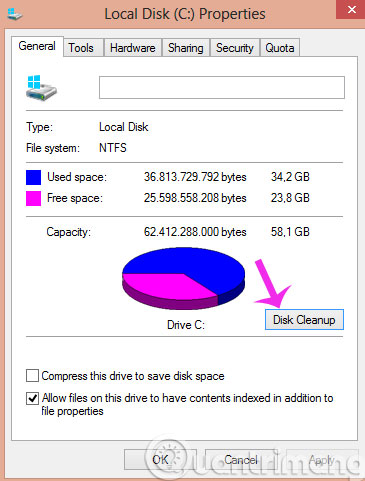
When the Disk Cleanup dialog box opens, check the Temporary Internet Files box and click OK
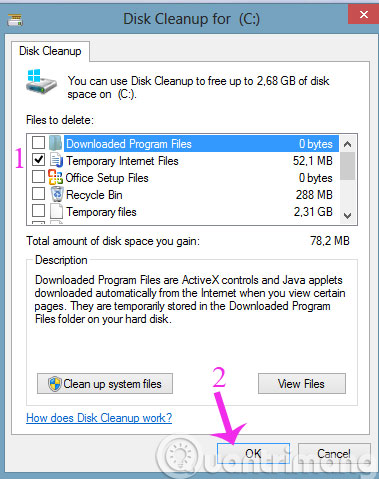
3- Delete Thumbnail Cache
Windows has a nice feature that displays the preview image of MP4 video files with the format defined as .PNG . And of course these images are created from File Explorer and they are saved for faster view later.
To delete Thumbnail Cache , still in the Disk Cleanup dialog box, check the Thumbnails box and click OK
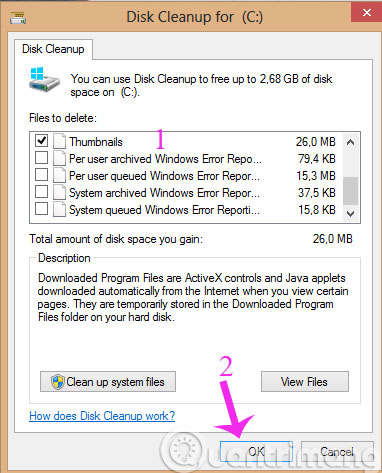
4- Clear the System Restore Cache
It can be said that System Restore is one of the very useful features in Windows. It is an excellent solution for quickly restoring the system to a previous stable state. However, the only downside of this feature is that it uses a lot of storage space. Therefore, if you sometimes feel unnecessary, you should delete System Restore restore points to free up storage space.
Go to Control Panel > System and Security > System . At the System interface, click System protection
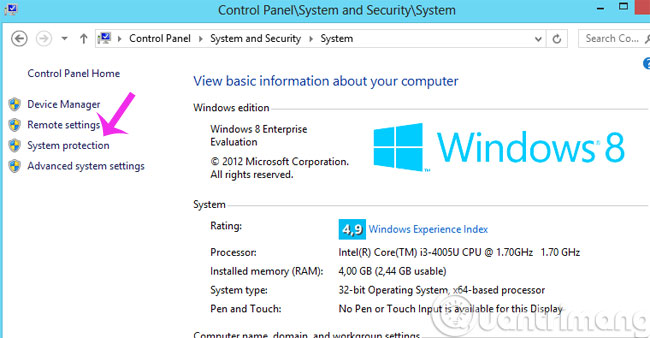
The System Protection dialog box appears, click the Configure option and then press Delete to finish.
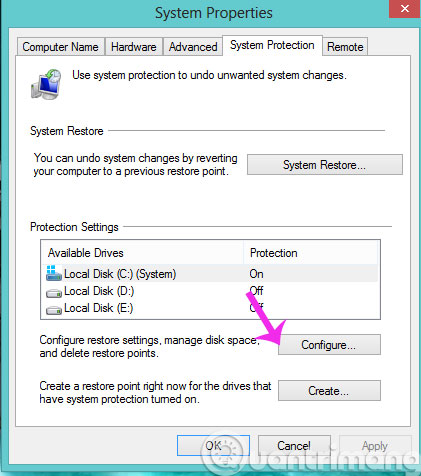
5- Clear the cache of the web browser
Similar to other software, web browsers also store cache data in web browsing sessions so that subsequent visits are faster. And if you say the agent produces the most cache, the web browser is the # 1 cause now.
With Chrome : Settings > Show advanced settings . > Clear browsing data > tick the option Cached Images and Files and select The beginning of time . Finally, click Clear browsing data .
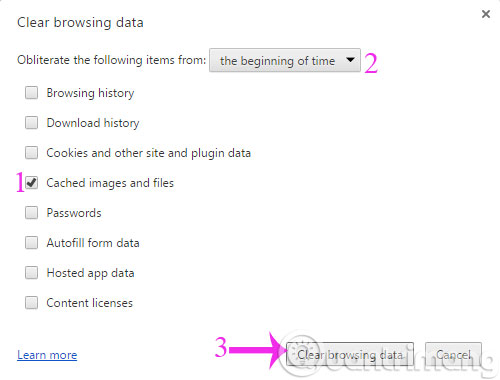
With Firefox : Go to the Tools menu> Customize > Advanced and click the Networks tab. Next, in the Cached Web Content section, click Delete Now .
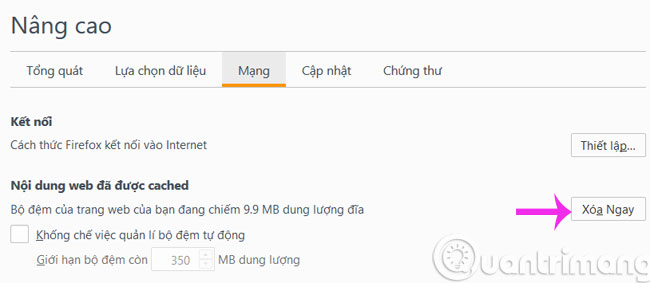
6- Clear cache of DNS
Most Internet service providers run their own DNS servers, however, information can also be retrieved from other DNS server cache. The router can also act as a DNS server, which stores information from the Internet service provider's DNS servers. Your computer also has a local DNS cache, so it can quickly consult a lookup rather than doing it on another DNS server.
However, when the router's DNS data changes, the previous cache data becomes obsolete and often causes web page loading problems. Therefore, "cleaning up" it is also a must.
Enter the following command into Command Prompt and press Enter : ipconfig / flushdns
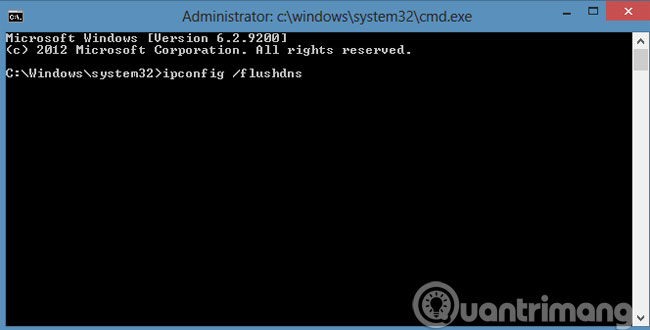
- How to launch Admin rights application for User account in Windows?
- 2 ways to hide hard disk partitions on Windows
- Fixed a bug when Libraries folder opened automatically when booting the computer
Hope the article will be useful to you!
You should read it
- How to use Cleaner for PC Pro to delete cache, Windows junk files automatically
- How to automatically clean junk on Windows 10 computers
- How to use Cleanmgr + clean the drive, clear the browser cache
- How to clean junk files and speed up Windows with Clean Master
- Clean junk computer Windows 10, Windows 7 most effectively
- How to use Clean Master to clean up, speed up Windows
- How to clear browsing data with Clear Cache for Chrome
- How to turn on auto-release memory mode Windows 10 Creators Update
May be interested
- How to hide 6 folders in This PC on Windows 10
 when you open this pc on windows 10, you will see 6 folders including desktop, pictures, documents, videos, download, music. so how to hide these folders when opening this pc?
when you open this pc on windows 10, you will see 6 folders including desktop, pictures, documents, videos, download, music. so how to hide these folders when opening this pc? - How to hide the system tray on Windows 10?
 if the system tray (system tray) on your windows 10 computer has some icons of important programs on your computer ...., and you want to hide these icons but you're worried about not knowing how to do it please refer to the steps in the following article of network administrator.
if the system tray (system tray) on your windows 10 computer has some icons of important programs on your computer ...., and you want to hide these icons but you're worried about not knowing how to do it please refer to the steps in the following article of network administrator. - Hide value 0 in Excel
 in the process of working with excel spreadsheets, for some reason, sometimes you want to hide all zero values. to do this, you only need to perform very simple steps, but if you do not pay attention you may not know how to do it.
in the process of working with excel spreadsheets, for some reason, sometimes you want to hide all zero values. to do this, you only need to perform very simple steps, but if you do not pay attention you may not know how to do it. - Instructions for using Hide My Ass to hide IP
 hide my ass (also called hidemyass or hma) is a leading vpn provider, trusted by many users, with more than 9000 ip addresses in 24 countries. today's article will show you how to download, install and use hide my ass to hide ip.
hide my ass (also called hidemyass or hma) is a leading vpn provider, trusted by many users, with more than 9000 ip addresses in 24 countries. today's article will show you how to download, install and use hide my ass to hide ip. - How to hide and show files in Windows 11 without software
 if you are looking for a way to hide files on windows 11 without software, then just follow the instructions below.
if you are looking for a way to hide files on windows 11 without software, then just follow the instructions below. - Examine the process of turning garbage into street bricks and clothes in Japan
 visit one of the modern waste treatment plants in tokyo to know how effective japanese waste disposal is!
visit one of the modern waste treatment plants in tokyo to know how effective japanese waste disposal is! - Offer Hide Anything, the security application that helps file on Windows 10 for $ 19.99, is free
 hide anything is a security application, which helps users to hide, hide documents and important content of any file format on windows 10 with password protection.
hide anything is a security application, which helps users to hide, hide documents and important content of any file format on windows 10 with password protection. - How to hide and show the recycle bin on Windows 11
 knowing how to hide and show the recycle bin on windows 11 will help you free up workspace on your computer's desktop as well as hide some secret documents in the recycle bin.
knowing how to hide and show the recycle bin on windows 11 will help you free up workspace on your computer's desktop as well as hide some secret documents in the recycle bin. - How to turn off / hide Facebook nick even when online
 with just a few simple steps, you can completely hide yourself while online on facebook, have more privacy and avoid being bothered.
with just a few simple steps, you can completely hide yourself while online on facebook, have more privacy and avoid being bothered. - How to hide and unhide all desktop icons on Windows
 many programs installed on windows automatically add icons to the desktop, causing your desktop to become tangled and often have to be removed. if you prefer a clean desktop, you can hide all icons on your computer screen.
many programs installed on windows automatically add icons to the desktop, causing your desktop to become tangled and often have to be removed. if you prefer a clean desktop, you can hide all icons on your computer screen.









 Disable the NVIDIA component to speed up the computer
Disable the NVIDIA component to speed up the computer How to use Bitlocker to encrypt data on Windows 10 (Part 1)
How to use Bitlocker to encrypt data on Windows 10 (Part 1) How to use Bitlocker to encrypt data on Windows 10 (The last part)
How to use Bitlocker to encrypt data on Windows 10 (The last part) Instructions for encrypting USB or memory cards with Bitlocker on Windows 10
Instructions for encrypting USB or memory cards with Bitlocker on Windows 10 12 ways to open CMD - Command Prompt easily on Windows 10
12 ways to open CMD - Command Prompt easily on Windows 10 Learn about the Quick Access Toolbar on Windows 10
Learn about the Quick Access Toolbar on Windows 10